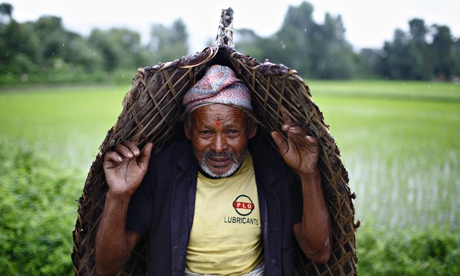
In Banke district along the West Rapti river basin in Nepal, farmers have noticed that floods are coming more often, and with greater intensity. Flooding has always been part of the annual cycle of life, but the past 40 years have seen 12 abnormally large floods that have eroded land and wiped out crops and buildings. Each major flood costs the average household the equivalent of $9,000 (£5,200).
In Nepal, where the average household annual income in 2011 was $2,700, these floods are a huge financial burden.
This story is replicated across Nepal. Between 1983 and 2010, every year floods have, on average, resulted in 283 deaths, 8,000 homes destroyed and 29,000 families affected, and dented Nepal's economy as a whole.
A recent study by the Nepali government and the Climate Development Knowledge Network (CDKN) has quantified the economic impact of these floods and other risk areas for today, and in the future. The study found that when both direct costs to infrastructure, as well as health and welfare impacts are considered, the total annual costs of these floods is, on average, $232m per year.
And the situation is expected to worsen. The climate in Nepal is already changing, with higher temperatures and more erratic rainfall patterns. The study, which used downscaled climate model simulation projections for Nepal, anticipates temperature increases of 3-5C by the end of the century.
The government's ambitious targets for economic growth, including graduating from least-developed to developed country status by 2022, is at serious risk, according to the study's findings. The agriculture and hydroelectricity sector are two of the major drivers of economic growth in Nepal, both of which will be significantly affected by climate change in the future.
Around three-quarters of Nepal's population relies on agriculture for income, and it contributes a third of the country's GDP. By the 2070s, climate change is projected to lead to a net decrease in crop productivity with resulting high economic costs that are estimated at $140m a year.
Hydroelectric plants provide roughly 90% of total electricity in the country and are expected to be a key driver for achieving Nepal's economic growth targets. The government's 2030 Development Vision anticipates a structural shift in the economy away from agriculture towards electricity, gas and water, with hydropower exports being a critical sector. However, "run-of-river" plants, which are the most common type in Nepal, rely on predictable rainfall and river flows.
The study has calculated that the additional stress of climate change on hydroelectricity production is already costing the equivalent of 0.1% of GDP per year on average, and 0.3% in very dry years. Together with floods and the impact on agriculture, these three risk areas could cost Nepal the equivalent of 2-3% of current GDP a year by mid-century.
However, it is possible to adapt to the impacts of climate change, and prevent this loss of economic growth. Banke district residents have tried to adapt to the increased flooding. Those who can afford it have reinforced the foundations of their homes or raised them on plinths. Some have changed their farming patterns to grow crops that better withstand the water. But for many, if the situation continues to worsen, they will lose the ability to cope with the impacts of the floods. Some residents are already considering migrating from the area.
These adaptation actions also come with associated costs. A significant increase in investment beyond that forecast by the government is needed in these sectors to reduce the impacts of climate change. The study projected additional investment required between now and 2030 to mainstream adaptation into planned development activities. This came to an additional $500m in the hydroelectricity sector, $1.7bn in the agriculture sector and $209m for tackling water-induced disasters.
So then comes the crux of one of the key international debates – who should pay for the impact of climate change? Certainly the private sector will play a role, particularly for agriculture and electricity production. For example, there is a business case for a commercial farmer to invest in irrigation to ensure higher yields when rainfall becomes more erratic. But a significant burden will still fall on the Nepal government, which will also need to draw on international support.
Fortunately, in making the case for increased levels of international climate finance, the government now has the economic data to make a strong argument. Significant investment will be needed for adaptation and to prevent the stalling of economic growth in the country.
For those in Banke district who are uncertain of what the near future holds, questions about who is responsible and who should pay seem far away. It is learning how to survive and adapt that is the immediate concern.
Elizabeth Gogoi is the project manager, Asia at the Climate and Development Knowledge Network. Follow @cdknetwork on Twitter.
Read more stories like this:
• Meet the women trading Sudan's first carbon credits
• Africa's best hope of combating climate change is to share knowledge
• The first climate justice summit: a pie in the face for the global north
Join the community of global development professionals and experts. Become a GDPN member to get more stories like this direct to your inbox

